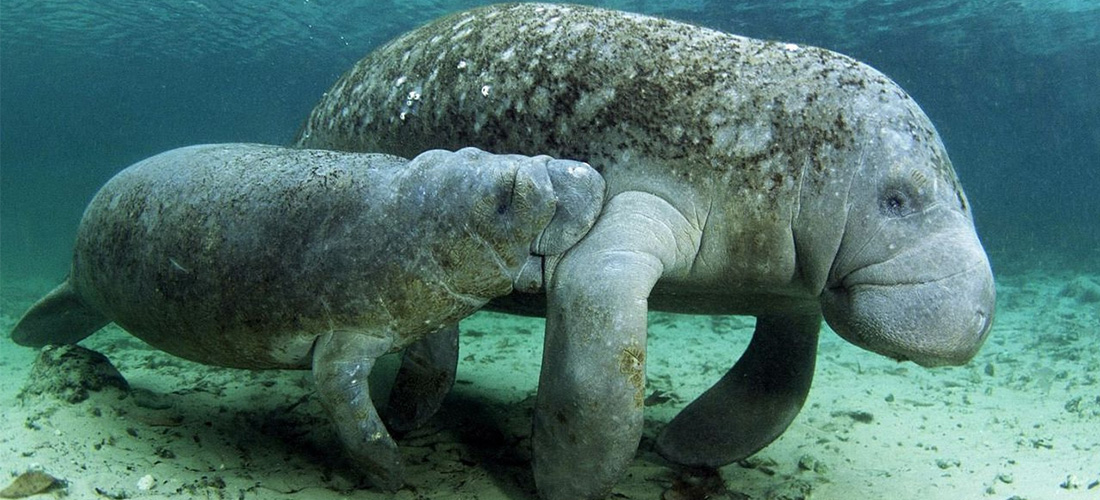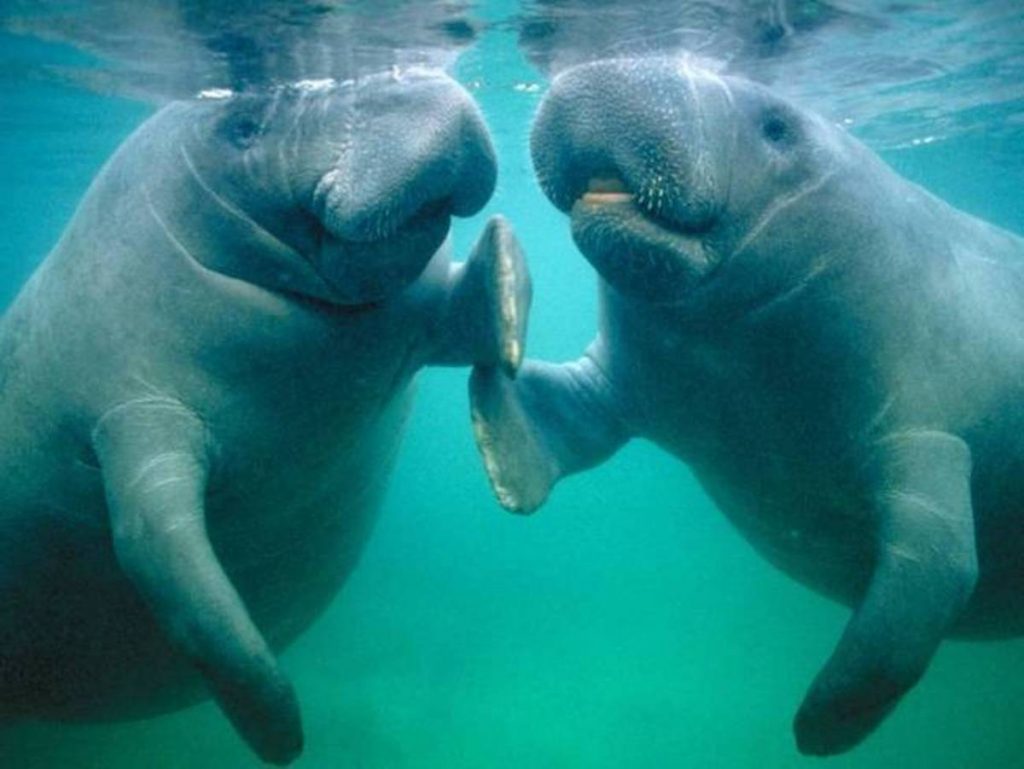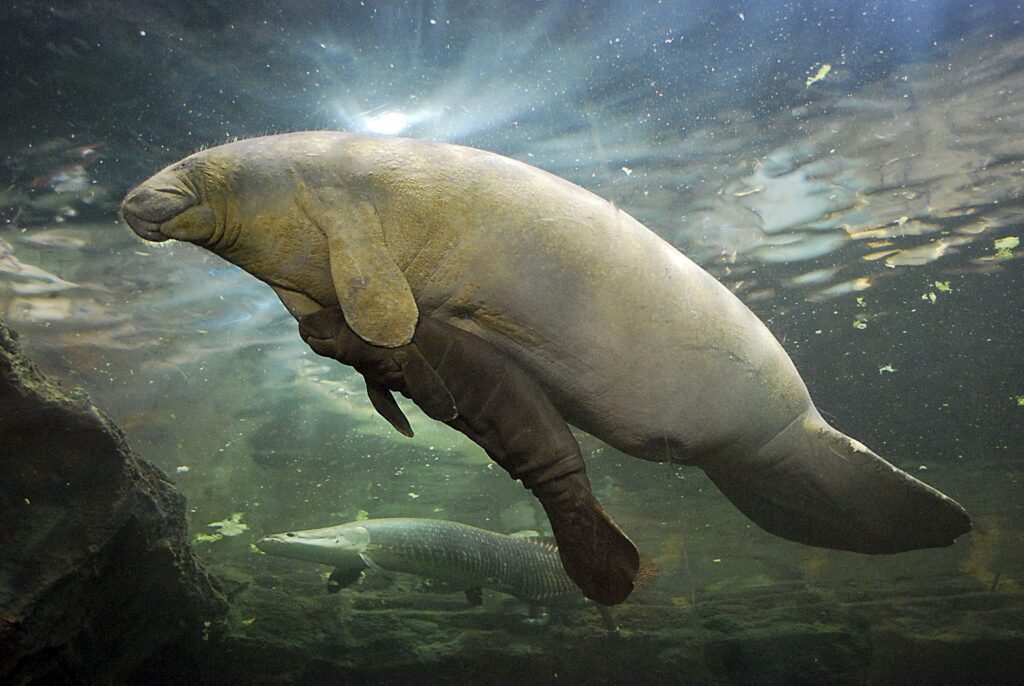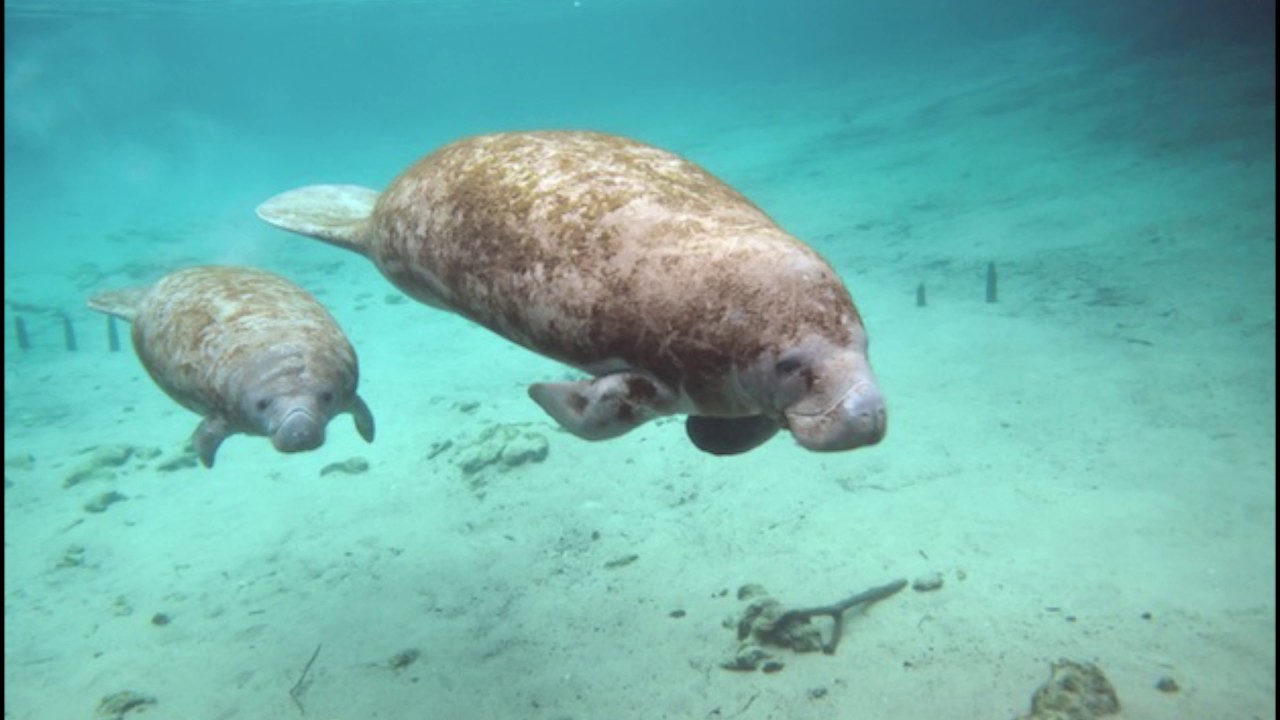The Manatee, sea cow or trichechus constitutes a genus of sirenid mammalian animals that are part of the trichechid family (Trichechidae) and is the only one that represents this family. If you want to know everything about the manatee, we recommend that you continue reading this article.
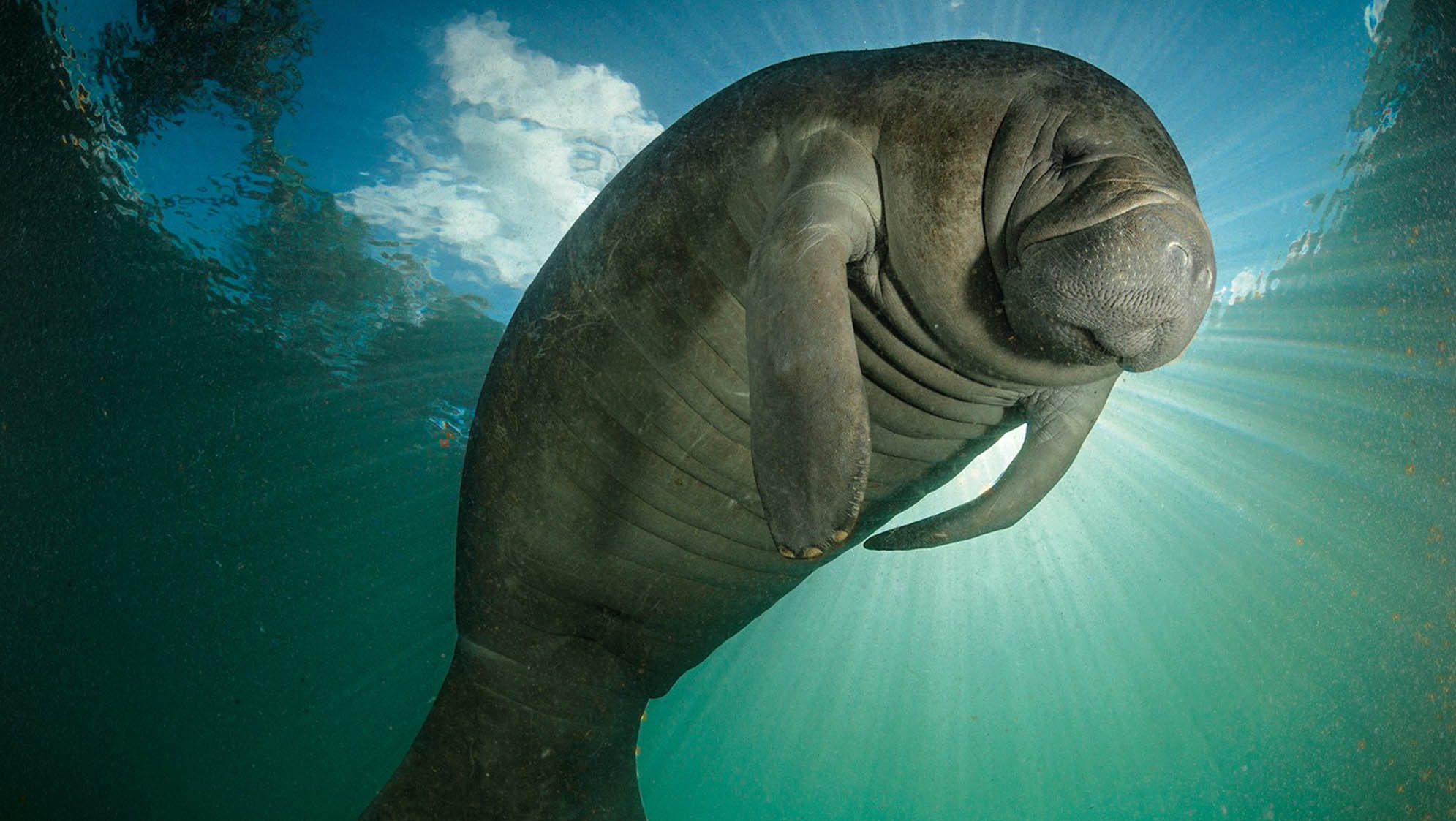
The Manatee
It is known for being a very tame animal and its diet is herbivorous, most of the time they use it to search for and eat plants from the shores and seabeds of shallow waters. The manatee spends its life both in salt water and in fresh water, but very close to the coasts of Africa and America.
The only predator of this animal is the human being, and despite the fact that it has not been verified, it can be presumed that on some occasion the killer whales have been able to attack the manatee, because the manatee, being a large, fat and very slow, so they are ideal prey for killer whales.
But due to the geographical distribution of trichechids, which are essentially found in coastal waters and very shallow, as well as in fresh waters located in the tropics, in which killer whales can practically not be found, we have the belief that the manatee is safe from predation.
Meaning of his name
The word manatee in the indigenous language of the Caribbean, means with moms. But its scientific name derives from the Latin word trichechus, which refers to small hairs or bristles that can be observed on its body, while manatus derives from the Greek word μανάτος or manatos, which is related to a particularity that is common to all. mammals because they suckle their young.
Other names used to designate them are tlakamichin, which is a combination of the Nahuatl words tlaka, which means man, and michin, which means fish; and awakash which means water cow, also in Nahuatl.
Taxonomy
According to scientists, this genus is made up of 3 species that are:
- Trichechus manatus – Caribbean or Florida manatee
- Trichechus senegalensis – African manatee
- Trichechus inunguis – Amazonian manatee
Although other researchers claim that there is a fourth species, which is:
- Trichechus pygmaeus – pygmy manatee
Description of the Manatee
The West Indian manatee is a large marine mammal, its color is gray, it has a body that shrinks on flat surfaces, and its tail is shaped like a paddle or spoon. It has two extremities that form the arms, which may look like fins, but each one has three or four claws. Their head and face are full of wrinkles and they have whiskers on their snout, because they don't have a mouth.
Its closest relatives are elephants and hyraxes, which are small mammals the size of gophers. It is believed that the manatee has evolved from a part aquatic herbivorous animal.
The West Indian manatee is related to the West African manatee, the Amazonian manatee, the dugong, and the Steller's sea cow, the latter of which was hunted until it became extinct in 1768. The standard adult manatee reaches measure approximately three meters in length and can weigh approximately 550 kilos.
Habitat and distribution
The manatee lives in shallow water, slow-moving rivers, saltwater bays, canals, coastal areas, and estuaries, especially where there is a meadow with aquatic grasses or where freshwater vegetation is abundant. Keep in mind that manatees are a migratory species, so they will go to those places where food is more favorable.
In the United States, they are located in the state of Florida during the winter time. For the summer months we can find it on the coasts of the western state of Texas and in the north up to the state of Massachusetts, but they have been seen in the states of South Carolina, Georgia and Alabama in summer.
In the case of the Antillean manatee, its habitat is found on the coast and rivers of Central America and on the north coast of South America, although its presence in these areas is very discontinuous, everything will depend on the conditions of the environment. water, climate and food.
Distribution according to species
The species trichechus senegalensis lives off the coast of West Africa; the trichechus inunguis lives on the east coast of South America and in the Amazon rivers, and the third, the trichechus manatus, lives in the Antilles and rivers and estuaries in that region of the Caribbean Sea, particularly around the coasts of the Dominican Republic , a place where there are relevant nature reserves, being the first country in which laws were created to protect them.
The Florida manatee is classified as a subspecies, called Trichechus manatus latirostris, and the West Indian manatee is classified as another subspecies, Trichechus manatus manatus.
In recent times, a fourth species of manatee has been described, as we have already mentioned, the dwarf manatee or trichechus bernhandi. It is a species close to the Amazonian manatee, which may be a subspecies, and which only reaches 1,3 m in length and its habitat is very restricted, barely 120 km on the banks of the Aruainho River, which is a tributary of the Aripuanii, where there are waters with currents and it feeds in a horizontal position.
The West Indian manatee lives distributed between Mexico, Belize, Guatemala, Honduras, Nicaragua, Costa Rica, Panama, Colombia, Venezuela, Trinidad, Guyana, Suriname, French Guiana, Brazil, Puerto Rico, the Dominican Republic, Jamaica, Cuba and in the Bahamas.
Food
Being the Manatee a herbivorous animal, it feeds on different plants, such as algae and mangrove leaves. To eat their food they use their upper lip, which is divided, which is a physiognomic characteristic. An adult manatee can normally consume up to nine percent of its body weight, which is about 50 kilos per day. It is usual for the manatee to eat fish from time to time.
Behavior
Because it is a mammalian animal, the manatee has to rise to the surface to breathe air, since they have a pulmonary system. Their way of resting is to dive to the bottom, just below the surface of the water, and they breathe every three to five minutes on average, but when they have displayed a great deal of energy, they must come up and stay on the surface breathing every thirty seconds.
But when it is at rest, it has been proven that the manatee can be submerged in the water for twenty minutes. The manatee can swim at a speed of thirty kilometers per hour when the distance is short, but its normal swimming speed is between five and eight kilometers per hour.
Life expectancy, mortality and population
The manatee has no natural enemies and its life expectancy is thought to be 60 years or more. As in all species of animals that live in the wild, a percentage of manatee mortality is attributed to natural causes, such as cold stress, gastrointestinal problems, pneumonia and other common illnesses.
A high percentage of deaths are linked to human causes. A significant number of manatee deaths are due to collisions with boats in Florida, also due to being squeezed or drowned in locks or structures to control floods or ingesting hooks, garbage, or cables and becoming entangled in lines of cages for crabs.
In recent times, the deterioration and loss of their habitat is the most serious threat that manatees have had to face worldwide. It is sad to report that according to Florida researchers, in 2011 the manatee population was 4.834 individuals.
Reproduction
Its numerical values of reproduction are low, to this it must be added that the manatee is not suitable for reproduction until it reaches five years of age. According to studies, a manatee calf is thought to be born within two to five years, and double births are extremely rare. The period is so long because the gestation period of a manatee is thirteen months and they need time to care for their young before having another.
As we indicated before, every 2 to 5 years a female gives birth to a calf, which weighs approximately thirty-five kilos at birth, with measurements between 90 to 120 centimeters in length. From the first moment, the young depend absolutely on their mother to subsist and remain by her side for at least two years.
In this species, it is only the mother who is in charge of the care and feeding of the young, feeding it with milk until its teeth are well formed and allow it to process and feed on plants by itself. The young are adults when they reach four years of age and their reproduction is sexual through internal fertilization.
Threats and protection
The manatee has been a victim of hunting for its meat and fat, but it is currently a protected species.
Unfortunately, the Antillean or Caribbean manatee, as it is also called, is today a species that is in danger of extinction. Its natural habitat has been reduced by the invasion of man, being reduced in many areas. Due to this, natural reserves have had to be created, such as the Río Dulce, in Guatemala, which seems to be one of the last protected areas for the manatee.
In the case of the Florida manatee, because it is distributed above the Tropic of Cancer line, it has been observed that they congregate most of the time in areas close to artificial heat sources such as power plants.
What happens when they do this is that they don't make their migratory movement and they start to depend on that artificial source of heat, but when you close the plants it is necessary to proceed to heat the waters to prevent the disappearance of the manatee population.
On July 15, 2014, the Costa Rican Congress declared the manatee as its national symbol of marine fauna, with the aim of promoting its preservation, while on July 23, 2019, Adán Augusto López Hernández, Governor of Tabasco declared Jonuta, in Tabasco, Mexico, as a protected area for the manatee.
Legal Protection
The Antillean manatee is currently considered one of the animals in danger of extinction, within Appendix I of CITES (Convention on International Trade in Endangered Species of Wild Fauna and Flora); so that any type of trade in products that originate from manatees is prohibited.
The IUCN (International Union for Conservation of Nature) also considers the West Indian manatee (Trichechus manatus manatus) in danger of extinction. It is good to know that the entire sirenia genus is protected by the protocol of the Cartagena Convention (SPAW) that prohibits the taking, killing, buying or selling of manatees, including parts or products made from manatees.
Wildlife reserves where Manatees are found
Below we can see the different places where Manatees live:
- Leather and salty – Honduras
- Chocón Machacas Protected Biotope (in the Río Dulce basin, Lake Izabal) – Guatemala
- Chetumal Bay – Mexico
- Estero Hondo – Dominican Republic
- Jaragua National Park – Dominican Republic
- Bay of the Eagles – Dominican Republic
- Tortuguero National Park – Costa Rica
- Turuépano National Park – Sucre State – Venezuela
- Bararida Zoological and Botanical Park – Lara State – Venezuela
- Leather and Salado Wildlife Refuge – La Ceiba, Atlántida – Honduras
- Sanctuary of the manatee - Poblado the birds - Los buchecos Jonuta, Tabasco, Mexico
- Lagoon of Catazaja Chiapas; Mexico
- Laguna de Caratasca Biological Reserve – Thank God (Honduras)
- San San Pod Sak Bocas del Toro, Panama
We recommend these other interesting articles:
- Marine animals
- Land animals
- Farm animals
